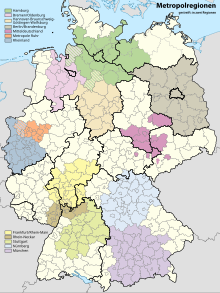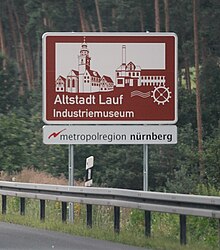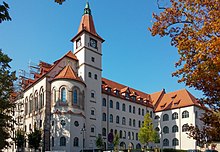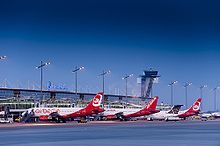Nuremberg metropolitan region
| logo | |
|---|---|

|
|
| map | |

|
|
| Basic data for the Nuremberg Metropolitan Region | |
| State : | Bavaria , Thuringia |
| Administrative districts : |
Upper Franconia , Middle Franconia , Lower Franconia , Upper Palatinate |
| Area : | 21,785 km² |
| Residents : | 3,560,823 (December 31, 2019) |
| Population density : | 164 inhabitants / km² |
| Structure: | 11 independent cities , 23 districts |
The metropolitan region of Nuremberg has a population of almost 3.6 million on an area of 21,800 square kilometers. With a gross domestic product of 134 billion euros and around 1.9 million people in employment, it is one of the most economically powerful areas in Germany. In the core, the so-called Nuremberg region, 2.5 million people live with around 1.4 million employees.
The European Spatial Development Concept (ESDP) from 1999 assigns the region an important bridging function with regard to the new EU member states in the east.
The Nuremberg region has been a member of METREX , the network of European metropolitan regions and metropolitan areas, since April 2003 .
On April 28, 2005, the Ministerial Conference for Spatial Planning (MKRO) formally decided on the recognition of the Nuremberg region as a metropolitan region .
Area of the Nuremberg Metropolitan Region
The metropolitan region of Nuremberg includes the eleven cities of Ansbach , Amberg , Bamberg , Bayreuth , Coburg , Erlangen , Fürth , Hof , Nuremberg , Schwabach and Weiden as well as the 23 districts of Amberg-Sulzbach , Ansbach , Bamberg , Bayreuth , Coburg , Erlangen-Höchstadt and Forchheim , Fürth , Haßberge , Hof , Kitzingen , Kronach , Kulmbach , Lichtenfels , Neumarkt idOPf. , Neustadt an der Aisch-Bad Windsheim , Neustadt an der Waldnaab , Nürnberger Land , Roth , Sonneberg , Tirschenreuth , Weißenburg-Gunzenhausen and Wunsiedel i. Fichtel Mountains .
The independent city of Hof has seen itself as a connection between the metropolitan regions of Nuremberg and Central Germany since joining .
Geographically, the European Metropolitan Region Nuremberg (EMN) thus encompasses the administrative region of Middle Franconia , all of Upper Franconia , two regional authorities in Lower Franconia and around half of Upper Palatinate, and since October 1, 2013, the Council of the Nuremberg Metropolitan Region has unanimously approved the admission of the city of Sonneberg (Thuringia). On April 2, 2014, the association assembly of the metropolitan region voted unanimously for the district of Sonneberg to join .
On July 15, 2010 the Würzburg city council decided to leave the metropolitan region of Nuremberg.
The geographical center of the Nuremberg metropolitan region , determined by a Mercator projection , is located near the village of Geschwand in the municipality of Obertrubach in the Forchheim district (49 ° 42'31.3 "N 11 ° 19'00.6" E).
| city | Residents Dec. 31, 2019 |
Area km² | Inhabitants / km² mean |
country |
|---|---|---|---|---|
| Ansbach | 41,798 | 100 | 418 |
|
| On the mountain | 42.207 | 50 | 842 |
|
| Bamberg | 77,373 | 55 | 1,416 |
|
| Bayreuth | 74,783 | 67 | 1,117 |
|
| Coburg | 41,072 | 48 | 851 |
|
| gain | 112,528 | 77 | 1,462 |
|
| Fuerth | 128,497 | 63 | 2,028 |
|
| court | 45,825 | 58 | 790 |
|
| Nuremberg | 518.370 | 186 | 2,781 |
|
| Schwabach | 40,981 | 41 | 1004 |
|
| Willows in the Upper Palatinate | 42,743 | 71 | 606 |
|
| Planning region Nuremberg (cities) | 800.376 | 368 | 2.174 |
|
| total | 1,166,177 | 816 | 1,429 |
| area | Residents Dec. 31, 2019 |
Area km² | Inhabitants / km² mean |
|---|---|---|---|
| One district cities | 1,166,177 | 816 | 1,429 |
| Counties | 2,394,646 | 20,969 | 114 |
| Nuremberg planning region | 1,353,032 | 2,934 | 461 |
| total | 3,560,823 | 21,785 | 164 |
organization
The eleven European metropolitan regions in Germany do not have any guidelines for internal structures. The manner of regional cooperation can therefore be adapted to the local structural conditions. The Nuremberg Metropolitan Region has opted for a decentralized and extremely democratic organizational structure. Internally, it is divided into six specialist forums, a steering committee and the council. Over 300 representatives from various areas of society - business, science, politics, administration, culture and sport - work on joint projects in the forums. The steering committee consists of representatives of the above-mentioned specialist forums and takes on tasks of strategic advice to the council, the actual decision-making body of the EMN. This consists of the mayors of the independent cities, the district administrators and the mayors of the most populous communities in the associated districts. Two members of the Bavarian state government , three state secretaries from Bavarian state ministries, as well as a district president and a district council president - representing all affected government and district councils - were co-opted.
Since the decision-making power lies entirely in the hands of elected political representatives, the Nuremberg Metropolitan Region is an institution of regional cooperation with a high degree of legitimacy . Due to the advisory effect of economic and cultural actors as well as the strong representation of rural areas, it is socially as well as geographically decentralized.
Treatment focus on cancer
The metropolitan region has been focusing on the treatment of the widespread disease cancer since 2013 . The German Cancer Aid has included the Erlangen University Hospital in the list of top oncological centers and is funding it with three million euros. The University Clinic Erlangen , the Clinic Bayreuth and the Social Foundation Bamberg are now jointly forming the Franconian Comprehensive Cancer Center of the European Metropolitan Region Nuremberg (CCC Erlangen - EMN).
Education and Research
There are several universities and technical colleges in the Nuremberg Metropolitan Region:
- East Bavarian Technical University of Amberg-Weiden
- Ansbach University
- Otto Friedrich University of Bamberg
- University for Protestant Church Music Bayreuth
- University of Bayreuth
- Coburg University
- Friedrich-Alexander University Erlangen-Nuremberg
- Wilhelm Löhe University of Applied Sciences , Fürth
- University for the Public Service in Bavaria, Department of General Internal Administration , Hof
- College yard
- Augustana University in Neuendettelsau
- Academy of Fine Arts Nuremberg
- Evangelical University of Nuremberg
- Nuremberg University of Music
- IBS International Business School , Nuremberg
- Technical University of Nuremberg Georg Simon Ohm
- Technical University of Nuremberg
- University of Applied Management Treuchtlingen
- Weihenstephan-Triesdorf University of Applied Sciences
As part of the top cluster competition of the Federal Ministry of Education and Research , the knowledge-intensive cluster "Medical Valley European Metropolitan Region Nuremberg" with actors from science, business and politics won a five-year grant.
traffic
Road traffic
Three major continental and three regional motorways run through the Nuremberg Metropolitan Region :
| Highway | course |
|---|---|
| Netherlands - Rhine-Ruhr - Rhine-Main - Würzburg - Erlangen - Nuremberg - Regensburg - Passau - Austria | |
| France - Saarbrücken - Rhine-Neckar - Ansbach - Schwabach - Nuremberg - Amberg - Czech Republic | |
| Berlin - Leipzig - Hof - Bayreuth - Nuremberg - Ingolstadt - Munich | |
| Schweinfurt - Bamberg - Bayreuth - Czech Republic | |
| Thuringia - Coburg - Bamberg - Erlangen - Fürth - Nuremberg | |
| Hof - Weiden - Regensburg - Munich |
Rail transport
The central station Nürnberg is the only station in the price category 1 in the metropolitan area is He is at the intersection of the. Inter City Express -lines 18 , 25 , 28 , 29 , 31 , 41 , 91 and the Inter City - and Euro City -lines 28 , 31 , 61 . These lines serve Nuremberg for the most part at hourly intervals, with line overlapping in some cases also resulting in denser clock frequencies. Almost all long-distance connections leading from Munich to the north are now bundled via the high-speed route to Nuremberg and are only divided here. This creates a dense cycle between the two cities even in long-distance traffic. With the completion of the high-speed route between Nuremberg and Leipzig , this relation and thus the connection to Berlin was also significantly accelerated. Long-distance trains also offer direct connections to the Rhine-Main and Ruhr areas , as well as to Stuttgart , Karlsruhe , Bremen , Hamburg and Passau and Vienna .
Other long-distance traffic stops in the metropolitan region are the stations of Ansbach , Bamberg , Coburg , Erlangen , Fürth , Kronach , Lichtenfels and Treuchtlingen .
The following night trains also run via Nuremberg Central Station:
| Train number | Train run |
|---|---|
| 420/421 | Innsbruck - Munich - Nuremberg - Frankfurt / Main - Cologne - Düsseldorf |
| 40490/40491 | Vienna - Linz - Nuremberg - Frankfurt / Main - Cologne - Düsseldorf |
| 40420/40421 | Innsbruck - Munich - Nuremberg - Hanover - Hamburg |
| 490/491 | Vienna - Linz - Nuremberg - Hanover - Hamburg |
| 424/425 | Innsbruck - Munich - Nuremberg - Frankfurt / Main - Cologne - Brussels |
| 50425/50490 | Vienna - Linz - Nuremberg - Frankfurt / Main - Cologne - Brussels |
| ASN1 / ASN2 | Salzburg - Munich - Nuremberg - Frankfurt / Main - Hamburg - Sylt |
Air traffic
- Nuremberg Airport (International Airport)
- Bamberg-Breitenau airfield (national airport without scheduled flights, only for sports and business)
- Bayreuth airfield (regional airport without scheduled flights)
- Herzogenaurach airfield (regional airport without scheduled flights)
- Hof-Plauen airfield (regional airport with taxi and business flights)
Web links
- European Metropolitan Region Nuremberg (EMN)
- Literature on the Nuremberg Metropolitan Region in the catalog of the German National Library
- Regional Monitor - The basic statistical work of the Nuremberg Metropolitan Region
- The Nuremberg Metropolitan Region on the website of the Planning Association for the Middle Franconia Industrial Region
Individual evidence
- ↑ European Metropolitan Region Nuremberg. (PDF; 383 kb) Data and facts. In: https://www.metropolregionnuernberg.de . Marketing Association of the European Metropolitan Region Nuremberg eV, August 1, 2018, accessed on October 1, 2018 .
- ↑ The metropolitan region at a glance. Facts and figures. In: metropolregionnuernberg.de. Retrieved June 5, 2018 .
- ^ Statistics viewer of the metropolitan regions in Germany. Employees subject to social security contributions. In: ftp.planungsverband.de. Retrieved September 29, 2019 .
- ^ City of Nuremberg, Office for Urban Research and Statistics for Nuremberg and Fürth (ed.): Statistical Yearbook of the City of Nuremberg 2017 . January 2018, ISSN 0944-1514 , 19 European Metropolitan Region Nuremberg, p. 254 ( nuernberg.de [PDF; 4.1 MB ; accessed on November 17, 2018]).
- ^ Bayerischer Rundfunk, October 2, 2013: Nuremberg Metropolitan Region. Sonneberg becomes a member outside Bavaria ( Memento from October 4, 2013 in the Internet Archive )
- ↑ MDR: April 2, 2014: Also the district of Sonneberg in the metropolitan region of Nuremberg ( Memento from April 7, 2014 in the Internet Archive ).
- ↑ Close decision: the city leaves the metropolitan region. In: mainpost.de . July 16, 2010. Retrieved July 16, 2010 .
- ↑ The metropolitan region of Nuremberg. Different dialects and one goal. In: https://www.metropolregionnuernberg.de . Marketing Association of the European Metropolitan Region Nuremberg eV, accessed on October 1, 2018 .
- ↑ Route network of the ÖBB Nightjets
- ↑ ÖBB Nightjet train numbers
- ↑ See https://www.stadtwerke-bamberg.de/unternehmen/beteiligungen/sonderlandeplatz-bamberg-breitenau/ , accessed on December 10, 2019







